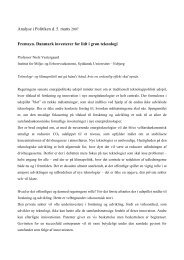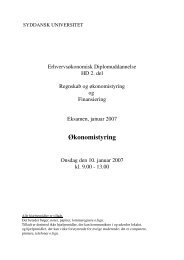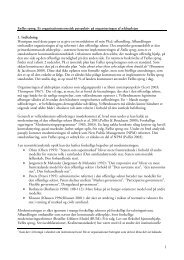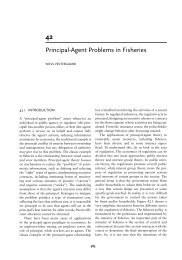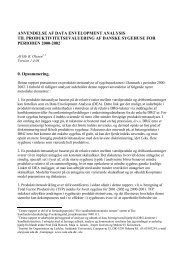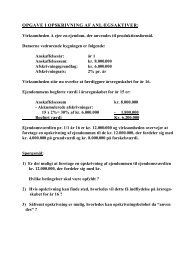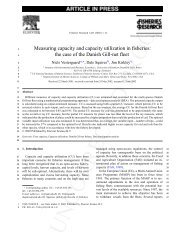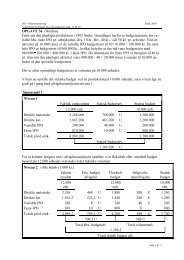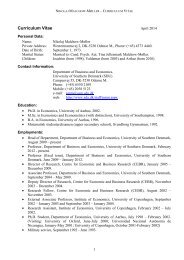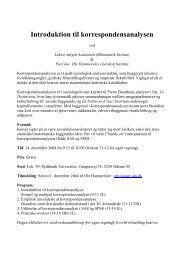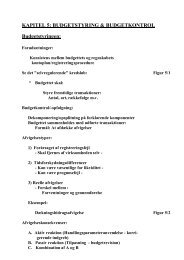Furthermore, the polarisation on elite level do not necessarily reflect the dom<strong>in</strong>ant cleavages <strong>in</strong>society. After three year with post-communism almost half <strong>of</strong> the Polish population was dissatisfiedwith the way Polish democracy was conducted <strong>and</strong> a majority also disagreed with the <strong>in</strong>terference<strong>of</strong> church <strong>in</strong> politics. In most cases the protests were expressed as dem<strong>and</strong>s about replacement <strong>of</strong><strong>in</strong>dividual politicians, not as a rejection <strong>of</strong> the pr<strong>in</strong>ciple about democracy as the “best possiblesolution”. In other words, the specific support to democracy <strong>and</strong> democratic <strong>in</strong>stitutions was low,but the diffuse support relatively high.At the beg<strong>in</strong>n<strong>in</strong>g party members, party leaders <strong>and</strong> local structures did not play a significant role <strong>in</strong>the parties’ communication strategies. The political leaders <strong>in</strong> general considered the mass media asmore effective means <strong>of</strong> contact<strong>in</strong>g voters than rely<strong>in</strong>g on party members (Szczerbiak, 2001:114).Institutionally there was small evidence that the new Polish parties were attempt<strong>in</strong>g to encapsulatetheir supporters by develop<strong>in</strong>g networks <strong>of</strong> ancillary structures directly l<strong>in</strong>ked to their partyorganisations, e.g. youth, women's <strong>and</strong> ecological sections (Szczerbiak, 2001:111). New Polishparties seemed to be strongest at the level <strong>of</strong> state <strong>in</strong>stitutions <strong>and</strong> also appeared capable <strong>of</strong> fulfill<strong>in</strong>gtheir role <strong>in</strong> terms <strong>of</strong> structur<strong>in</strong>g elections, <strong>in</strong>stitutions <strong>and</strong> recruit<strong>in</strong>g elites (Szczerbiak, 2001:126).The Pasants <strong>Party</strong> (PSL) has been the only party with a rural base <strong>and</strong> left w<strong>in</strong>g SdRP the only partywith an organizational network <strong>in</strong> big as well as small towns. The new parties such as. the FreedomUnion (UW) <strong>and</strong> AWS seemed to bear a closer resemblance to the catch-all, electoral-pr<strong>of</strong>essional<strong>and</strong> cartel parties than traditional mass parties. The new movement parties <strong>in</strong> the CEECs had not<strong>in</strong>herited the <strong>in</strong>itial membership, organisational base <strong>and</strong> level <strong>of</strong> party identification that Westernparties had accumulated hav<strong>in</strong>g operated <strong>in</strong> a competitive electoral environment <strong>in</strong> many years(Szczerbiak, 2001:124).As noted above, <strong>in</strong> the late 1990s numerous ad hoc coalitions <strong>and</strong> electoral alliances have emerged,e.g. AWS <strong>and</strong> ”Przymierze Polski”. A change toward a more bipolar <strong>and</strong> moderate multipartysystem with stronger l<strong>in</strong>kages to social cleavages <strong>in</strong> society could be observed with the centre-leftparty federation (SLD) <strong>and</strong> the centre-right party federation (AWS) constitut<strong>in</strong>g the two ma<strong>in</strong> poles.The situation changed strik<strong>in</strong>gly <strong>in</strong> 2000-2001, i.e. after the 2000 presidential election <strong>and</strong>, notleast, after the parliamentary election <strong>in</strong> September 2001. In the same decade, only three parties ranfor election under the same party label. <strong>Party</strong> leaders moved to “neighbour parties”, <strong>of</strong>ten severaltimes <strong>and</strong> mostly for personal career. The voters preferences tended to be rather stable, but not theparties. Thus, parties, that obta<strong>in</strong>ed about 30 pct <strong>of</strong> the votes at the 2001 election, simply did notexist <strong>in</strong> 2000, i.e. <strong>in</strong>ly one to two years back <strong>in</strong> time. After the 2001 election we were basically back<strong>in</strong> the situation before the 1993 election, however, with an even stronger populist <strong>and</strong> xenophobicparty representation <strong>in</strong> the Sejm. More than 20 parties <strong>in</strong> opposition to SLD at the 1991 election, didnot exist 10 years later.After the 2001 election the SLD-UP-PSL government did obta<strong>in</strong> the majority <strong>in</strong> the Sejm due to themove toward a strict proportional election system more favourable for small parties, thereby mak<strong>in</strong>gthe establishment <strong>of</strong> government with a majority beh<strong>in</strong>d <strong>in</strong> parliament more complicated comparedwith the situation after the previous election. In return, there was support from a “post-communist”president (Aleks<strong>and</strong>er Kwasniewski) <strong>and</strong> a majority <strong>of</strong> SLD-UP <strong>and</strong> PSL <strong>in</strong> the upper house(Senate). However, <strong>in</strong> general Polish politics became clearly more unstable due to the strongerrepresensation <strong>in</strong> parliament <strong>of</strong> “anti-system” parties like Samoobrona <strong>and</strong> the Leage <strong>of</strong> PolishFamilies (LPR)46
The persistent fall <strong>in</strong> electoral support due to bad governance, grow<strong>in</strong>g economic <strong>and</strong> socialproblems <strong>and</strong> lack <strong>of</strong> cohesion on government <strong>and</strong> party level led to the resignation <strong>of</strong> LeszekMiller as SLD party chairman <strong>and</strong> premier, <strong>in</strong>ternal division <strong>of</strong> SLD <strong>and</strong> establishment <strong>of</strong> atransitory government led by Marek Belka, which <strong>in</strong> June 2004 won a vote <strong>of</strong> confidence by anarrow marg<strong>in</strong> (236 aga<strong>in</strong>st 215)2.2. Solidarity <strong>and</strong> AWSOver 20 years, from 1980 to 1989 Solidarity had been the lead<strong>in</strong>g <strong>in</strong> the fight aga<strong>in</strong>st the old statestocilist system (“we” versus “them”) based “s<strong>of</strong>t” as well as “hard” Catholic ideology. Pragmaticattitudes <strong>and</strong> self-limitation went h<strong>and</strong> <strong>in</strong> h<strong>and</strong> with active resistance aga<strong>in</strong>st the communists, butthe “<strong>in</strong>ternalisation <strong>of</strong> limits” from the late 1989 due to the “Gorbachev factor” faded away soonafter the demise <strong>of</strong> the old system <strong>and</strong> the crisis <strong>and</strong> subsequent systemic collapse <strong>of</strong> the SovietUnion.The phenomenon Solidarity was unique. The dom<strong>in</strong>ant model underly<strong>in</strong>g Solidarity <strong>in</strong> manyrespects resembled the social-democratic. Several mutually compet<strong>in</strong>g myths <strong>and</strong> contra-mythsextisted <strong>in</strong>side Solidarity movement, all aim<strong>in</strong>g to make more sense <strong>and</strong> predictability <strong>in</strong> a chaoticextraord<strong>in</strong>ary situation. In other words, new mutually comtet<strong>in</strong>g symbols, utopia <strong>and</strong> myths forcedout communist ideology 41 . From its work<strong>in</strong>g class base to the struggle to realize greater control overenterprises, Solidarity resembled a socialist type movement <strong>in</strong> all but name. Hardly any other tradeunion <strong>in</strong> the world has at the same time been <strong>in</strong> government <strong>and</strong> constitut<strong>in</strong>g a political party <strong>and</strong> an<strong>in</strong>terest organisation <strong>in</strong> the classical sense. Moreover, dur<strong>in</strong>g its 21 years’ history Solidarity hadalternately a social protest with a built-<strong>in</strong> self-limitation, a trade union focus<strong>in</strong>g on short-termeconomic <strong>in</strong>terests <strong>and</strong> a catch-all movement <strong>in</strong> a society undergo<strong>in</strong>g deep <strong>and</strong> fast changes. Itstarted <strong>in</strong> 1979-80 as a trade union, a democratic movement <strong>and</strong> a force <strong>of</strong> national <strong>in</strong>dependence.Later Solidarity appeared as a political party <strong>in</strong> the more classical sense, even becom<strong>in</strong>g a party <strong>of</strong>government try<strong>in</strong>g to change a socially, economically <strong>and</strong> culturally backward <strong>and</strong> socially dividedsociety.In addition, Solidarity has alternately been a trade union, a political mass movement <strong>and</strong> a reflexivemovement (”pozycji refleksji”) represent<strong>in</strong>g a specific “anti-political third way” <strong>of</strong> th<strong>in</strong>k<strong>in</strong>g. At theoutset Solidarity constituted as a political mass movement, which took trade union shape. Before1989 the defence <strong>of</strong> work<strong>in</strong>g class short-term <strong>in</strong>terests was brought <strong>in</strong> the background as a defence<strong>of</strong> workers <strong>in</strong>terests provided a fundamental change <strong>of</strong> the state socialist system. In stead,extrication <strong>and</strong> blackmail<strong>in</strong>g were strik<strong>in</strong>g. Concrete plans <strong>and</strong> strategies for transform<strong>in</strong>g Polishsociety were postponed until the victory over the “post-communists” had been achieved (Morawski1998:74).Before 1989 the fight aga<strong>in</strong>st the old system constituted a zero-sum play, almost a “w<strong>in</strong>-loosergame”, <strong>and</strong> the disagreement <strong>in</strong>side the movement was suppressed <strong>in</strong> the name <strong>of</strong> collectivestrength. The pr<strong>in</strong>ciple <strong>of</strong> ”strength through unity” was reflected <strong>in</strong> the territorial <strong>and</strong> regionalstructures. The political declarations were kept <strong>in</strong> abstract <strong>and</strong> symbolic value forms, <strong>in</strong> most cases<strong>in</strong>clud<strong>in</strong>g slogans about social justice, democracy, truth, rule <strong>of</strong> law, human rights <strong>and</strong> nationalcommunity.41 Leszek Koczanowicz, ”Cztery mity ”Solidarnosci”, Gazeta Wyborcza 21-22 August 2004:15-16.47
- Page 3: “This provisional situation chara
- Page 6 and 7: marketisation and privatisationshor
- Page 8 and 9: purposes, are channels for “expre
- Page 10 and 11: the significance of strategic choic
- Page 12 and 13: presidentialism gave rise to “flo
- Page 14 and 15: antipolitics and reinforcement of a
- Page 16 and 17: In the late 1990’s elections most
- Page 18 and 19: determined primarily by “politica
- Page 20 and 21: politics and antipolitics, all sign
- Page 22 and 23: which attitudes to state regulation
- Page 24 and 25: Anti-communism has been defined in
- Page 26 and 27: elections and the Slovak communists
- Page 28 and 29: Cartel agreementsbetter representat
- Page 30 and 31: Basically the absence of clear cons
- Page 32 and 33: After 1989 different types of polit
- Page 34 and 35: complex project for transition unde
- Page 36 and 37: window of opportunity in spite of s
- Page 38 and 39: analyses of party institutionalizat
- Page 40 and 41: political messages and slogans. Thu
- Page 42 and 43: well established party culture may
- Page 44 and 45: expected, much due to the many spli
- Page 48 and 49: Finally, Solidarity can also be con
- Page 50 and 51: whole, on the one side an authorita
- Page 52 and 53: The economic recession and the grav
- Page 54 and 55: election defeat more cooperation an
- Page 56 and 57: The formation of AWS can be conside
- Page 58 and 59: group. RS AWS constituted the Chris
- Page 60 and 61: According to the original plans the
- Page 62 and 63: values. According to Rybicki, as so
- Page 64 and 65: AWS should fight against all types
- Page 66 and 67: 2001 parliamentary election, howeve
- Page 68 and 69: and workers voted ZChN. At the 1993
- Page 70 and 71: The League has been considered as a
- Page 72 and 73: establishment like than LPR’s. Th
- Page 74 and 75: jobs in rural areas, especially sma
- Page 76 and 77: industrial policy. According to the
- Page 78 and 79: pressurizing the government to give
- Page 80 and 81: democrats, thereby locating itself
- Page 82 and 83: To conclude, the Freedom Union (UW)
- Page 84 and 85: Polish middle class. Thus, in Janua
- Page 86 and 87: such as KSCM and KSS in The Czech R
- Page 88 and 89: The SLD leaders were mainly recruit
- Page 90 and 91: the falling popular support for pri
- Page 92 and 93: innovation was formation of the pol
- Page 94 and 95: place after talks with each applica
- Page 96 and 97:
Has the Left any freedom of manoeuv
- Page 98 and 99:
medicine, changes in the labour cod
- Page 100 and 101:
The Labour Union (UP), Democratic U
- Page 102:
Nevertheless, before that had taken



